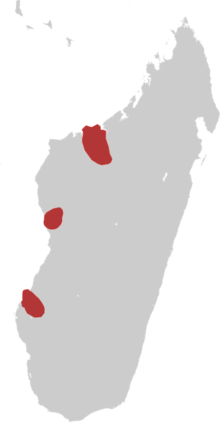This is an old revision of this page, as edited by Laurencedmcgill (talk | contribs) at 22:46, 12 November 2021 (Added a Behavior section with references and links.). The present address (URL) is a permanent link to this revision, which may differ significantly from the current revision.
Revision as of 22:46, 12 November 2021 by Laurencedmcgill (talk | contribs) (Added a Behavior section with references and links.)(diff) ← Previous revision | Latest revision (diff) | Newer revision → (diff) Species of bird
| Sakalava rail | |
|---|---|
| Conservation status | |
 Endangered (IUCN 3.1) | |
| Scientific classification | |
| Domain: | Eukaryota |
| Kingdom: | Animalia |
| Phylum: | Chordata |
| Class: | Aves |
| Order: | Gruiformes |
| Family: | Rallidae |
| Genus: | Zapornia |
| Species: | Z. olivieri |
| Binomial name | |
| Zapornia olivieri (G. Grandidier & Berlioz, 1929) | |

| |
| Distribution of the Sakalava rail | |
| Synonyms | |
|
Amaurornis olivieri (Grandidier & Berlioz, 1929) | |
The Sakalava rail (Zapornia olivieri) is a species of bird in the family Rallidae. It is endemic to western Madagascar. This bird is small with brown upperpart feathers, grey underparts, a yellow bill and red legs.
The habitat of this rail species is freshwater marshes of reed Phragmites mauritianus. It is classified as Endangered and is threatened by habitat loss due to the destruction of wetlands in Madagascar.
Description
Sakalava Rail measures 19 cm with grey underparts, a yellow bill and red eyes. This rail species exhibits some evidence of sexual dimorphism of different body size and colours. Males are smaller, thinner, have rufous brown upperparts and bright red shanks. Females are larger, have brown green upperparts and pale pink shanks. Juvenile and immature Sakalava Rails look very similar to females. ] Although 34 microsatellite loci, which are molecular markers of polymorphism, were produced for this species, additional research is needed to confirm sexual dimorphism using DNA or voice analysis.
Habitat
Sakalava Rail lives in marshes of open water and dense reedbeds of Phragmites mauritianus. These lotic marshes also contain many floating plant species such as native ferns (Salvinia), water lilies (Nymphaea lotus and Nymphaea nouchali) and invasive water hyacinths (Eichhornia crassipes).
Distribution
Sakalava rail has a restricted distribution in Madagascar due to a small and fragmented population. This rail species has been historically recorded between the Mahavavy river in the north and the Mangoky river in the south. Its population was estimated at 215 individuals with a largest single population of 62 birds following surveys conducted in 2003-2006. During this study, Sakalava rails were located at five locations: Lake Kinkony, Ampandra, Amparihy, Sahapy and Mandrozo. In 2016, the IUCN Red List estimated that the population ranges between 250 and 999 mature individuals. Although few observations have been made, the species is suggested to have a declining population.
Behavior and Ecology
Sakalava rails are found alone or in pairs. They walk slowly over floating vegetation and turn ferns with their bills to catch prey when feeding. When scared, they run and briefly fly to hide into deep vegetation. They are commonly predated by Yellow-billed kite (Milvus aegyptius) and Madagascar coucal (Centropus toulou).
The Sakalava rail’s peak breeding period lasts from September to November, but there is some evidence that this rail species could have a longer breeding period lasting year round. Some active nests and young Sakalava rails have been observed during the wet season in February and March.
Both sexes participate in parental care activities during the breeding season: from building the nest, incubating the eggs, and feeding the chicks. No evidence of cooperative breeding by helpers have been observed for the Sakalava rail.
References
- ^ BirdLife International (2016). "Zapornia olivieri". IUCN Red List of Threatened Species. 2016: e.T22692654A93363104. doi:10.2305/IUCN.UK.2016-3.RLTS.T22692654A93363104.en. Retrieved 11 November 2021.
- ^ Rabenandrasana, Marc; Zefania, Sama; Long, Peter; The Seing, Sam; Clémentine Virginie, Marie; Randrianarisoa, Mihaja; Safford, Roger; Székely, Tamas (March 2009). "Distribution, habitat and status of 'Endangered' Sakalava Rail of Madagascar". Bird Conservation International. 19 (1): 23–32. doi:10.1017/S0959270908008058. ISSN 0959-2709.
- ^ Rabenandrasana, Marc (February 2007). Conservation biology of Sakalava rail Amaurornis olivieri an Endangered Malagasy water bird and public awareness in Besalampy wetlands complex, Western Madagascar. Antananarivo, Madagascar: Ligue Malgache pour la Protection des Oiseaux.
{{cite book}}: CS1 maint: year (link) - Brede, Edward G.; Long, Peter; Zefania, Sama; Rabenandrasana, Marc; Székely, Tamás; Bruford, Michael (2010-02-13). "PCR primers for microsatellite loci in a Madagascan waterbird, the Sakalava Rail (Amaurornis olivieri)". Conservation Genetics Resources. 2 (S1): 273–277. doi:10.1007/s12686-010-9189-2. ISSN 1877-7252.
- ^ Pruvot, Yverlin Z; René de Roland, Lily-Arison; Razafimanjato, Gilbert; Rakotondratsima, Marius PH; Andrianarimisa, Aristide; Thorstrom, Russell (2018-04-03). "Nesting biology and food habits of the endangered Sakalava Rail Amaurornis olivieri in the Mandrozo Protected Area, western Madagascar". Ostrich. 89 (2): 109–115. doi:10.2989/00306525.2017.1317296. ISSN 0030-6525.
External links
| Taxon identifiers | |
|---|---|
| Amaurornis olivieri | |
This Gruiformes-related article is a stub. You can help Misplaced Pages by expanding it. |